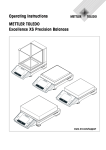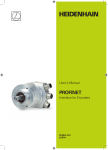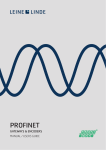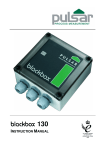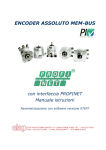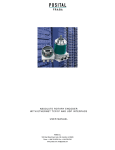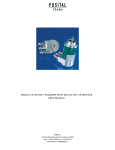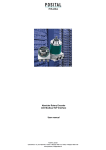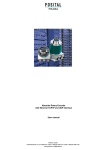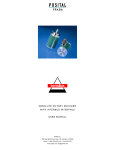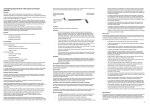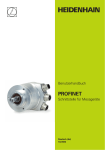Download absolute rotary encoder with profinet interface user manual
Transcript
ABSOLUTE ROTARY ENCO DER W ITH PROFINET INTERF ACE USER MANUAL FRABA Inc. 1800 East State Street, Suite 148, Hamilton, NJ 08609 Phone +1 609 750 8705, Fax. +1 609 750 8703 www.posital.com, [email protected] PROFINET USER MANUAL 3.8 Rotary encoder functions – data format ...14 Content Absolute ROTARY ENCODER ............................. 1 3.8.1 Base Mode Parameter ..........................15 3.8.2 Device Parameter .................................15 Content ............................................................. 2 3.8.3 Vendor Parameter.................................15 1. Introduction ................................................. 3 3.9 Rotary encoder function description ........17 3.9 Rotary encoder function description ........17 1.1 Absolute rotary encoder ............................ 3 1.2 PROFINET technology ............................. 4 1.3 Features of the Encoder ........................... 4 3.9.1 Code sequence .....................................17 3.9.2 Class 4 functionality ..............................18 3.9.3 Preset control for G1_XIST1 .................18 3.9.4 Scaling function control .........................18 Neighboring detection ............................. 4 3.9.5 Alarm channel control ...........................18 2. Installation ................................................... 5 3.9.6 Preset value ..........................................19 2.1 Electrical Connection ................................ 5 3.9.7 Offset value...........................................20 2.2 Ethernet cables ......................................... 5 3.9.8 Scaling parameters ...............................20 2.2.1 RJ45 – M12 crossed .............................. 5 3.9.9 Max. Master Sign-Of-Life failures .........20 2.2.2 RJ45 – M12 straight ............................... 5 3.9.10 Velocity measuring units .....................20 2.2.3 M12 – M12 crossed ............................... 5 3.9.11 Velocity filter .......................................21 2.3 Diagnostic LEDs ....................................... 6 3.9.12 Endless Shaft (RoundAxis) .................21 2.4 Status LED indication ................................ 6 4. Configuring with STEP7 ........................... 22 2.5 Instructions for mechanical installation and electrical connection of the rotary encoder ..... 7 4.1 Installing the GSDML file .........................22 4.2 Engineering a POSITAL encoder into a 3. Device configuration ................................... 8 STEP7 project................................................23 3.1 Standardization ......................................... 8 4.3 LLDP (Link Layer Discovery Protocol) .....25 3.2 Encoder Classes ....................................... 8 4.4 Selecting an encoder version ...................27 3.3 Encoder functions ..................................... 9 4.4 Setting encoder parameters .....................28 3.4 Signal list for Cyclic Data Transmission .... 9 4.5 Changing and reading encoder parameters 3.4.1 Format of actual position values .......... 10 at run-time......................................................28 3.4.2 Encoder control word (STW2_ENC) .... 11 4.6 Setting of device properties .....................29 3.4.3 Encoder status word (ZSW2_ENC) ..... 11 4.7 Sample of Variable table ..........................30 3.4.4 Encoder control word (G1_STW) ......... 12 4.8 IRT settings..............................................31 3.4.5 Encoder status word (G1_ZSW) .......... 12 3.5 Standard telegrams................................. 13 3.6 Configuration principle ............................ 14 3.7 Rotary encoder functionality overview .... 14 Version 07/09 Page 2 5 FAQ .............................................................. 32 6 Glossary ...................................................... 34 11 Revision index .......................................... 35 UMUS-OCD-EI PROFINET USER MANUAL Imprint FRABA Inc. 1800 East State Street Alterations of specifications reserved Hamilton, NJ 08609 Phone +1 609 750 8705 Technical specifications, which are described in this manual, are subject to change due to our Fax Internet +1 609 750 8703 http://www.posital.com permanent strive to improve our products. e-mail [email protected] Disclaimer of Warranty POSITAL GmbH makes no representations or Copyright The company POSITAL GmbH claims copyright on warranties, either express or implied, by or with respect to anything in this manual, and shall not be this documentation. It is not allowed to modify, to extend, to hand over to a third party and to copy liable for any implied warranties of merchantability and fitness for a particular purpose or for any this documentation without written approval by the company POSITAL GmbH. Nor is any liability indirect, special, or consequential damages. assumed for damages resulting from the use of the information contained herein. Further, this Version date: Version number: July 1, 2009 07.09 publication and features described herein are subject to change without notice. Article number: Author: n/a Reiner Bätjer 1. Introduction 30 This manual describes the implementation and configuration of an absolute rotary encoder with PROFINET interface. The device fulfills the requirements of a PROFINET IO device with RT (real time) or IRT (isochronous real time) classification. resolution is 30 bits = 2 = 1,073,741,824 steps. The standard single-turn version has 13 bits, the standard multi-turn version 25 bits. For further information about the function principle or the setup of a PROFINET network please, refer to http://www.profibus.com/pn. 1.1 Absolute rotary encoder The basic principle of an absolute rotary encoder is the optical sampling of a transparent code disc which is fixed with the driving shaft. The absolute rotary encoder has a maximum resolution of 65,536 steps per revolution (16 bits). The mutli-turn version can detect up to 16,384 revolutions (14 bits). Therefore the largest resulting Version 07/09 Page 3 UMUS-OCD-EI PROFINET USER MANUAL 1.2 PROFINET technology This channel is mainly of use for motion PROFINET is an Industrial Ethernet standard merging plant automation with other enterprise IT control applications. resources. It provides comparable functionality to PROFIBUS PROFINET IO uses a view of distributed I/O similar to PROFIBUS DP. IO controllers (e.g. PLCs) run an with techniques used by engineering, IT, and management personnel. automation program, IO devices (e.g. absolute encoders) are remotely assigned field devices, and Established IT standards are employed as basis of communication: TCP, UDP, IP. XML is used as IO supervisors (e.g. programming devices) are used for commissioning and diagnostics. description language for device profiles (GSDML files). The engineering of PROFINET IO is done similar to Two ways of using PROFINET are available: PROFINET IO, similar to PROFIBUS DP as a PROFIBUS. The field buses (i.e. Ethernet topologies) are assigned to control systems during distributed I/O system and PROFINET CBA as a modular component-based system for larger configuration. The IO device is configured in the actual system based on the contents of its GSDML systems. PROFINET offers scalable communication for file. After completion of the engineering the installer different applications in industrial automation: PROFINET NRT (non real time) is suited loads the data for the expansion into the IO controller (PLC) and the IO controller assumes data for non-time-critical process automation with clock rates of roughly 100 msec. exchange with the IO device. PROFINET RT (real time) offers a communication channel with optimized An IO device is addressed within PROFINET (and also possibly by external IT components) through performance (10 msec clock rate) for most factory automation tasks its IP address. PROFINET IRT (isochronous real time) employs special communication hardware Data can be exchanged from the IO controller to the IO device (and vice versa) cyclically (for process to enable clock rates of less than 1 msec and a jitter precision of less than 1 µsec. data). Apart from this, parameter data can be exchanged acyclically during engineering of the IO device or by the use of PLC programming blocks. 1.3 Features of the Encoder Integrated Boot loader for customer firmware upgrades Engineering identification call Different filters for velocity Round axis (Endless shaft) Used Profinet Encoder Profile V4 Neighboring detection Version 07/09 Page 4 UMUS-OCD-EI PROFINET USER MANUAL 2. Installation 2.1 Electrical Connection The rotary encoder is connected by a 4 pin M12 connector for the power supply and two 4 pin, The Encoder uses a second D-coded connector and provides integrated switch functionality. On or D-coded M12 connector for Ethernet. in the packaging of the connector is the mounting description. Connector Ethernet Connector power supply 4 pin female, D-coded 4 pin male, A-coded Pin Number Signal Pin Number Signal 1 Tx + 1 US (10 - 30 V DC) 2 Rx + 2 N.C. 3 Tx - 3 GND (0V) 4 Rx - 4 N.C. Sketch on encoder view 4 3 4 3 5 2 1 1 2 2.2 Ethernet cables 2.2.1 RJ45 – M12 crossed Signal RJ45 Pin M12 Pin 2.2.3 M12 – M12 crossed Signal M12 Pin M12 Pin Tx+ 1 2 Tx+ 1 1 Tx- 2 4 Tx- 2 2 Rx+ 3 1 Rx+ 3 3 Rx- 6 3 Rx- 4 4 2.2.2 RJ45 – M12 straight Signal RJ45 Pin M12 Pin Tx+ 1 1 Tx- 2 3 Rx+ 3 2 Rx- 6 4 Version 07/09 Page 5 UMUS-OCD-EI PROFINET USER MANUAL 2.3 Diagnostic LEDs LED Color Description for LED = on Active1 Yellow Incoming and outgoing traffic for port 1 Link1* Green Link to another Ethernet component for port 1 Active2 Yellow Incoming and outgoing traffic for port 2 Link2* Green Link to another Ethernet component for port 2 Stat1 Green Status 1, details in the next table Stat2 Red Status 2, details in the next table * Flashes with 2Hz if engineering identification call is activated and link connection is available 2.4 Status LED indication Status 1 Green Status 2 Red Meaning Cause (Bus failure) Off Off No power On On No connection to another device - bus disconnected Criteria: no data exchange - Master not available / switched off On Blinking 1) Parameterization fault, no data - Slave not configured yet or wrong exchange configuration Criteria: data exchange correct. - Wrong station address assigned However, the slave did not switch (but not outside the permitted range) to the data exchange mode. - Actual configuration of the slave differs from the nominal configuration On 1) Off Data exchange. Slave and operation ok. The blinking frequency is 0.5 Hz. Minimal indication time is 3 sec. Version 07/09 Page 6 UMUS-OCD-EI PROFINET USER MANUAL 2.5 Instructions for mechanical installation and electrical connection of the rotary encoder The following points should be observed: Route the connecting cable to the angular Do not open the angular encoder housing encoder at a considerable distance or completely separated from power cables (this does not mean that you cannot remove the connection cap). If the device with their associated noise. Completely shielded cables must be used for reliable is opened and closed again, it can be damaged and dirt may enter the unit. data transfer and good grounding must be provided. Cabling, establishing and The angular encoder shaft must be interrupting electrical connections may only be carried-out when the equipment is connected to the shaft to be measured through a suitable coupling (full shaft in a no-voltage condition. Short-circuits, voltage spikes etc. can result in erroneous version). This coupling is used to dampen vibrations and imbalance on the encoder functions and uncontrolled statuses which can even include severe personnel injury shaft and to avoid inadmissible high forces. Suitable couplings are available and material damage. from Posital. It is not permissible to make any electrical changes to the encoder. Do not drop the angular encoder or subject it to excessive vibration. The encoder is a precision device. The encoder should have got a large-area connection to PE. If the flange don’t have Although Posital absolute encoders are rugged, when used in tough ambient a good electrical connection to the machine – i.e. if there was used a plastic conditions, they should be protected against damage using suitable protective mounting device – then use i.e. a 30cm long and 2cm wide copper tape to get the measures. The encoder should not be used as handles or steps. PE connection. Only qualified personnel may commission Before powering-up the system, check all of the electrical connections. Connections, which are not and operate these devices. These are personnel who are authorized to correct, can cause the system to function incorrectly. Fault connections can result in severe commission, ground and tag devices, systems and circuits according to the personnel injury and material damage. current state of safety technology. Version 07/09 Page 7 UMUS-OCD-EI PROFINET USER MANUAL 3. Device configuration 3.1 Standardization This actual generation of PROFINET devices is based on the Encoder Profile V4 (PNO No. See the next figure with the coherences. 3.162). With this standardization it is possible to substitute all products that fulfill the specification. 3.2 Encoder Classes Application Class Description 3 Isochronous mode is not supported (RT) 4 Isochronous mode is supported (IRT) Version 07/09 Page 8 UMUS-OCD-EI PROFINET USER MANUAL 3.3 Encoder functions Implementation Function Class 3 Class 4 -/* G1_XIST1 Preset control -/* Scaling function control -/* -/* - - Measuring units per revolution / Measuring step -/* Total measuring range -/* Measuring units per revolution 64bit -/* Total measuring range 64bit -/* Maximum Master Sign-Of-Life failures -/* Velocity measuring unit -/* Encoder Profile version Code sequence Class 4 functionality Alarm channel control Preset value Preset value 64bit Operating time - - Offset value -/* Offset value 64 bit -/* Round axis (Endless shaft) Velocity filter * If Class 4 functionality is activated 3.4 Signal list for Cyclic Data Transmission Signal No. Significance Abbreviation Lenght (bit) 3 Master’s sign-of-life STW2_ENC 16 - 4 Slave’s sign of life ZSW2_ENC 16 - 6 Velocity value A NIST_A 16 8 Velocity value B NIST_B 32 9 Control word G1_STW 16 - 10 Status word G1_ZSW 16 - 11 Position value 1 G1_XIST1 32 - 12 Position value 2 G1_XIST2 32 - 39 Position value 3 G1_XIST3 64 - Version 07/09 Page 9 Sign UMUS-OCD-EI PROFINET USER MANUAL 3.4.1 Format of actual position values G1_XIST1 and G1_XIST2 are the actual position G1_XIST1 left aligned and G1_XIST2 right values in binary. For absolute encoders one format example is given below. NOTE: the aligned. The settings in the Encoder parameter data alignment in the data-frame (left or right-aligned) is considered for each individual resolution. affect the position value in both G1_XIST1 and G1_XIST2. Example: 25 bit Multiturn absolute encoder (8192 G1_XIST2 displays the error telegram instead of the position value if error occurs. steps per revolution, revolutions). distinguishable P979, Subindex 3 (Shift factor for G1_XIST1) =7 All values are presented in binary format The shifting factors in P979 "sensor format" P979, Subindex 4 (Shift factor for G1_XIST2) =0 4096 display the actual format. The default setting is M = Distinguishable Revolutions (Multiturn value) S = Pulses (Singleturn steps per revolution) 31 30 29 28 27 26 25 24 23 22 21 20 19 18 17 16 15 14 13 12 11 10 9 8 7 6 5 4 3 2 1 0 M M M M M M M M M M M M S S S S S S S S S S S S S 24 23 22 21 20 19 18 17 16 15 14 13 12 11 10 9 8 M M M M M M M M M M M M S S S S S 7 6 5 4 3 2 1 0 S S S S S S S S Absolute value in G1_XIST1 31 30 29 28 27 26 25 Absolute value in G1_XIST2 G1_XIST3 For 64bit position values is the G1_XIST3 available. The binary value will transmit right aligned and without shifting factor. IO Data Format Version 07/09 1 2 3 4 64 bit position value Page 10 UMUS-OCD-EI PROFINET USER MANUAL 3.4.2 Encoder control word (STW2_ENC) 4-Bit-counter, left justified. The master application starts the sign of life with any value between 1 values for the master’s sign of life are 1 to 15, “0” indicates an error and is left out in normal and 15. The master increases the counter in every cycle of the master application. Valid operation. Implementation Bit Function 0…9 Reserved, currently not used 10 Control by PLC 11 Reserved, currently not used 12…15 Controller Sign-Of-Life Class 3 Class 4 - Bit Value Significance Comments 10 1 Control by PLC Control via interface, EO IO Data is valid 0 No control by PLC EO IO Data is not valid. Except Sign-Of-Life Controller Sign-Of-Life Send continuous counting value from 0 to 15 12…15 3.4.3 Encoder status word (ZSW2_ENC) 4-Bit-counter, left justified. The slave application slave application in every DP-cycle. Valid values starts the sign of life with any value between 1 and 15 after successful synchronization to the for the slave’s sign of life are 1 to 15, “0” indicates an error and is left out in normal operation. clock pulse. The counter is increased by the Implementation Bit Function 0…8 Reserved, currently not used 9 Control requested 10…11 Reserved, currently not used 12…15 Encoder Sign-Of-Life Class 3 Class 4 Mandatory Mandatory - Mandatory Bit Value Significance Comments 9 1 Control requested The automation system is requested to assume control 0 No control by PLC EO IO Data is not valid. Except Sign-Of-Life Send back continuous Controller Sign-Of-Life (counting value from 0 to 15) 12…15 Version 07/09 Encoder Sign-Of-Life Page 11 UMUS-OCD-EI PROFINET USER MANUAL 3.4.4 Encoder control word (G1_STW) Bit Value Function 0 .. Comments Reserved, currently not used 10 11 0/1 „Home position mode“ Specifies if the position value shall be set to a previously programmed absolute value or shifted by this value. 0: set home position / preset (absolute) 1: shift home position / preset (relative = offset) 12 1 Set preset / request shift Preset (resp. shift) is set when changing this Bit to “1” (rising edge). Default preset value (shift): 0 Warning: After setting the preset the offset will be save in the non volatile memory. In this 5-10ms the encoder will not send position values. 13 1 Request absolute value cyclically Request of additional cyclic transmission of the absolute actual position in G1_XIST2. If no other data needs to be transferred due to commands or errors the absolute position value will be transmitted automatically. If the “activate parking sensor” bit is set, the encoder transmits no error messages. 14 1 Activate parking sensor 15 1 Acknowledging a sensor Request to acknowledge / reset a sensor error error 3.4.5 Encoder status word (G1_ZSW) Bit Value Meaning 0 Comment Reserved, currently not used .. 10 11 12 1 Acknowledgement Is set if the reset of a sensor error (after acknowledging) takes sensor error in process longer than one bus cycle. Set preset / shift Acknowledgement for “set preset / request shift” reference point executed Acknowledgement for “request absolute value cyclically“ 13 1 Transmit absolute value cyclically 14 1 Parking sensor activated Acknowledgement for “activate parking sensor“. The encoder transmits no error messages. 15 1 Sensor error Indicates a sensor error. A device specific error code is transmitted in G1_XIST2. Version 07/09 Page 12 UMUS-OCD-EI PROFINET USER MANUAL 3.5 Standard telegrams Standard Telegram 81 IO Data (DWord) 1 2 Setpoint STW2_ENC* G1_STW1* * Details about the variables are available in chapter 3.4 IO Data 1 (DWord) Actual value 2 3 4 5 ZSW2_ENC* G1_ZSW1* G1_XIST1* 6 G1_XIST2* Standard Telegram 82 IO Data (DWord) 1 Setpoint STW2_ENC* G1_STW1* IO Data 1 (DWord) Actual value 2 2 4 5 ZSW2_ENC* G1_ZSW1* G1_XIST1* Standard Telegram 83 IO Data (DWord) 1 Setpoint 6 7 G1_XIST2* NIST_A* 5 7 2 STW2_ENC* G1_STW1* IO Data 1 (DWord) Actual 3 2 3 4 ZSW2_ENC* G1_ZSW1* G1_XIST1* 6 8 G1_XIST2* NIST_B* 7 9 value Standard Telegram 84 IO Data (DWord) 1 Setpoint STW2_ENC* G1_STW1* IO Data 1 2 2 3 4 5 6 8 10 (DWord) Actual ZSW2_ENC* G1_ZSW1* G1_XIST3* G1_XIST2* NIST_B* value Version 07/09 Page 13 UMUS-OCD-EI PROFINET USER MANUAL 3.6 Configuration principle The rotary encoder with PROFINET interface can encoder has to be installed in the used PLC be programmed according to the needs of the user. The GSDML file pertaining to the rotary engineering software tool. 3.7 Rotary encoder functionality overview Function Communication channel Position value Cyclic input (IO device -> IO controller) Preset Cyclic output (IO controller -> IO device) Coding sequence Acyclic input/output Scaling function Acyclic input/output 3.8 Rotary encoder functions – data format PROFINET IO devices are set up in modules. Each module can be plugged in physical and/or logical PLCs there are in the GSDML-file two directories: Standard and Encoder Profile 4. slots. These are subdivided into sub slots individually to accommodate further data hierarchy. POSITAL rotary encoders offer for the standard profile one slot (address #0) with one sub slot One sub slot can contain several cyclic input/output channels as well as acyclic record channels (used (address #0) for all device data for old PLC’s that doesn’t support several sub slots. for parameters). There are two versions of PLC available. Some of Device parameters are grouped together as records in the PROFINET interface. The following table them support only one sub slot. Other ones i.e. S7 400 support several sub slots. To work with both gives an overview over addresses of POSITAL rotary encoder’s data channels. GSDML file Rotary encoder Acyclic data transmission (Parameters) PLC engineering software Version 07/09 Cyclic data transmission (process data) PLC Page 14 UMUS-OCD-EI PROFINET USER MANUAL Parameter for Acyclic Data Transmission 3.8.1 Base Mode Parameter Function Slot Sub slot Index Offset Length IO Code sequence 1 1 0xBF00 0.0 1 Bit - Class 4 functionality 1 1 0xBF00 0.1 1 Bit - G1_XIST1 Preset control 1 1 0xBF00 0.2 1 Bit - Scaling function control 1 1 0xBF00 0.3 1 Bit - Alarm channel control 1 1 0xBF00 0.4 1 Bit - Measuring units per revolution 1 1 0xBF00 1 8 Byte - Total measuring range 1 1 0xBF00 9 8 Byte - Maximum Master Sign-Of-Life failures 1 1 0xBF00 17 1 Byte - Velocity measuring unit 1 1 0xBF00 18 1 Byte - Preset value 1 1 0xB02E Via Parameter Number 65000 Function Slot Sub slot Index Offset Preset value 1 1 0xB02E Via Parameter Number 65000 Function Slot Sub slot Index Offset Length Velocity filter 1 1 0x1000 0 1 Byte - Endless shaft (Round axis) 1 1 0x1000 1 1 Byte - - 3.8.2 Device Parameter Length IO - 3.8.3 Vendor Parameter IO For PLC’s that support several sub modules the following table will be in use for the Encoder (Standard section in Device list, not no PDEV) Slot 0 Slot 1 Standard Telegrams Profile 4. Sub 0 Version 07/09 Sub 0 Sub 1 Sub 2 MAP (Parameter) Standard Telegram 81,82 or 83 Acyclic Data Channel Cyclic Data Channel Page 15 UMUS-OCD-EI PROFINET USER MANUAL 3.9 Patronized Parameter Parameter Read only PNU_922_TELEGRAM_SELECTION PNU_964_DEVICE_IDENT PNU_965_ENCODER_PROFILE_NUMBER Write only Read/Write PNU_971_STORE_LOCAL_PARAMS PNU_975_ENCODER_OBJECT_IDENT PNU_979_SENSOR_FORMAT PNU_980_NUMBER_LIST_OF_DEFINED_PARAM PNU_65000_PRESET_VALUE PNU_65001_OPERATING_STATUS Sample of configuration according Encoder Profile V4 Version 07/09 Page 16 UMUS-OCD-EI PROFINET USER MANUAL 3.9 Rotary encoder function description Implementation Function Class 3 Class 4 -/* G1_XIST1 Preset control -/* Scaling function control -/* -/* - - Measuring units per revolution / Measuring step -/* Total measuring range -/* Measuring units per revolution 64bit -/* Total measuring range 64bit -/* Maximum Master Sign-Of-Life failures -/* Velocity measuring unit -/* Encoder Profile version Code sequence Class 4 functionality Alarm channel control Preset value Preset value 64bit Operating time - - Offset value -/* Offset value 64 bit -/* Round axis (Endless shaft) Velocity filter * If Class 4 functionality is activated 3.9.1 Code sequence The parameter “code sequence“ defines the counting direction of the position value. The code increases when the shaft is rotating clockwise (CW) or counter-clockwise (CCW) (view onto the shaft). Code sequence Direction of rotation when viewing the shaft Code sequence 0 (default) Clockwise (CW) Increasing 1 Counter-clockwise (CCW) Decreasing Version 07/09 Page 17 UMUS-OCD-EI PROFINET USER MANUAL 3.9.2 Class 4 functionality The parameter “Class 4 functionality“ defines that the scaling, preset and code sequence affects the position value in G1_XIST1, 2 and 3. Class 4 control Class 4 function 0 (default) Deactivated 1 Activated 3.9.3 Preset control for G1_XIST1 The parameter “preset control“ defines the preset functionality. If parameter Class 4 is activated and Preset control is disabled then the Preset will not be affected for G1_XIST1. Preset control Preset function 1 Preset does not affect G1_XIST1 0 (default) G1_XIST1 is affected by a Preset command 3.9.4 Scaling function control The parameter “scaling function control“ enable / disenable the scaling function. If not, the physical Scaling function control Scaling function 0 Deactivated 1 (default) Activated position value is returned by the rotary encoder. This is only available if class 4 control is activated. 3.9.5 Alarm channel control The parameter “Alarm channel control“ defines the is deactivated then will only transmit the first 6 bytes length of diagnostic telegram. If the Alarm channel of diagnostic telegram. Alarm channel control Alarm channel function 0 (default) Deactivated 1 Activated Version 07/09 Page 18 UMUS-OCD-EI PROFINET USER MANUAL 3.9.6 Preset value With the Preset value it is possible to adapt the encoder zero point to the zero point of the NOTE: Set Preset only in standstill! application. When using this function the current encoder position value is set to the desired preset There is no preset activated when the Preset value is written to the encoder. The preset value. The integrated microcontroller calculates the internal zero point shift. It is stored in a permanent function is controlled by the bits in sensor control and status words (G1_STW and memory (~ 10 ms). G1_ZSW). The Preset value is used when a preset is requested by bit 12 in the Sensor control word (G1_STW). Parameter Meaning Data type Preset value Preset value will defined during startup or with asynchronous data exchange Integer 32 Function call for setting Preset = 100 Decimal (= 0x000000C8 hex) following with Request Header, Parameter-Address and -Value: Request Header : CALL " WR_REC" Byte 0) Req ID (Change parameter) REC Byte 1) Req Reference ID Byte 2) No. Of Parameters 1 INDEX 0xB02E LEN 16 0x02,0x00,0x01,0x00, Byte 3) DO-ID DONE BUSY ERROR STATUS RECORD Parameter Address: Parameter Value: 0x00,0x10,0xFD,0xE8,0x00,0x00, 0x01,0x43, 0x00,0x00,0x00,0xC8 Byte 0) No. Of Elements (0) Byte 0) No. of Values (1) Byte 1) Attribute ( Value) Byte 1) Format (0x43) (Integer32) Byte 2-3) Parameter number: 65000 (Preset ) Byte 2-5) Value (Preset = 100) Byte 4-5) Subindex Version 07/09 Page 19 UMUS-OCD-EI PROFINET USER MANUAL 3.9.7 Offset value The offset value is calculated in the preset function and shifts the position value with the calculated value. Parameter Meaning Data type Measuring units per revolution / Measuring step Single turn resolution in steps Unsigned 32 Total measuring range in measuring units Total measuring range measuring steps Unsigned 32 3.9.8 Scaling parameters The Scaling parameters will be used to change the output values if the Scaling function is the resolution. This parameter will only affect to activated. Parameter Meaning Data type Measuring units per revolution / Single turn resolution in steps Unsigned 32 Total measuring range measuring steps Unsigned 32 Measuring step Total measuring range in measuring units 3.9.9 Max. Master Sign-Of-Life failures With this parameter the number of allowed failures of the master’s sign of life is defined. Parameter Meaning Value Maximum Master Sign-Of-Life failures Number of permissible failures of the 1 … 255 master’s life sign 3.9.10 Velocity measuring units This parameter defines the coding of velocity With each cycle will calculate the velocity from measuring units used to configure the values NIST_A and NIST_B. Only Telegrams 82-84 the position value. To get a high velocity precision it is necessary to use a short cycle time. uses the velocity outputs. Velocity measuring unit Value Steps/s 0 Steps/100ms 1 Steps/10ms 2 RPM 3 Version 07/09 Page 20 UMUS-OCD-EI PROFINET USER MANUAL 3.9.11 Velocity filter The velocity value can used with three different moving averaging filter types. Default: Fine Parameter Meaning Data type Velocity filter Select for the parameter Fine, Normal, Coarse Integer 32 3.9.12 Endless Shaft (RoundAxis) Normally the period, i.e. “Total resolution” / revolutions. This means that i.e. 100 or 325 “measuring units” per revolution must be an integer and it must fit an integer number of times (integer revolutions could make trouble. So the following equation must apply: multiple) into 4096 for an encoder with 12 Bit for the (4096 x measuring units per revolution) / Total resolution = integer But with this Profinet encoder it is possible to solve this problem. If the Endless Shaft (Round axis) is “Auto” the encoder checks if the parameters need the endless shaft. “On” activate this functionality activated then this problem will be solved by the encoder. The default value is “Off”. With value = during the complete working time. Note: The internal software routine only works if the encoder is in operation. If it is necessary to turn the If the cycle time is ≤ 10ms then there will come four times over the total resolution a pause of sending encoder shaft more than 1024 revolutions without power supply this can lead to problems (the internal position values of 5-10ms because the offset value has to save in the non volatile memory. routine will not work without power supply). With this function there will be save additional values in the internal eeprom. Parameter Meaning Data type Endless Shaft (Round axis) Select for the parameter On, Off, Auto Integer 32 Version 07/09 Page 21 UMUS-OCD-EI PROFINET USER MANUAL 4. Configuring with STEP7 In the following chapter the configuration of the 315-2PN/DP or Simotion Scout with single axis POSITAL encoder with the configuration tool Hardwaremanager STEP 7 is shown exemplarily. In controller D410 (PROFINET controller integrated) are used. If there are questions about other this example STEP 7 Version 5.4 SP1 and the CPU software tools please contact the manufacturer. 4.1 Installing the GSDML file If POSITAL encoders are used for the first time it is necessary to install the GSDML file to import The GSDML file is supplied by POSITAL (free of charge from www.posital.eu). In order to represent encoder parameterization catalogue of the tool: hardware the encoder with a bitmap in STEP7 the bitmap file will be installed automatically with the GSDML file – Choose “Install GSD File...” in the “HW Config”window of the project (menu item “Options”) and both files must be in the same directory. The main number of the “Software Release” in the GSDML select the GSDML-file. file and the Firmware must be the same, i.e. 4.xx. Version 07/09 into the Page 22 UMUS-OCD-EI PROFINET USER MANUAL After the successful installation of the GSDML file the POSITAL encoder can be found in the hardware (Possibly, you need to update the hardware catalog by choosing “Options” -> “Update catalog”). catalog under „PROFINET-IO“ – „Additional Field Devices“ – „Encoders“ – „POSITAL OCD“. 4.2 Engineering a POSITAL encoder into a STEP7 project To engineer the rotary encoder into a project, drag PROFINET ethernet the device “OCD encoder” on to an existing network and double-click the “OCD encoder” icon). Double-click address of the POSITAL encoder. Also, under the the rotary encoder icon to set communication parameters that the PLC will use. Set a device name and by clicking “Ethernet” the IP Version 07/09 network (or choose the “IO cycle” tab, set the desired update time. Page 23 UMUS-OCD-EI PROFINET USER MANUAL The device name and IP address now have to be address of the chosen device to the previous set physically within the rotary encoder. Connect the PLC and rotary encoder to ethernet and switch window and select “Use IP parameters”. The MAC address is available on the type label on the bottom them on. Click “PLC” -> “Ethernet” -> “Edit Ethernet Node” and click “Browse” for accessible ethernet left (see picture below with red marking). Enter the IP address (and subnet mask) for the encoder that nodes in the new window. STEP7 will scan for devices on Ethernet and will displays them in a you previously assigned and click “Assign IP configuration”. Also, enter the device name window. The rotary encoder should be displayed under the device type “POSITAL OCD”. Select this previously chosen in the text field “Device name” and click “Assign Name”. entry and click “Flash” to have the identification LED flash with 2 Hz. Click “OK” to take the MAC Please note: If more than one rotary encoder is used in the same PROFINET network, each encoder must have a different name and each encoder must be assigned its name before another is connected to the network. Version 07/09 Page 24 UMUS-OCD-EI PROFINET USER MANUAL 4.3 LLDP (Link Layer Discovery Protocol) The Link Layer Discovery Protocol allows replacing a device of the Profinet-network. The partner port before and behind of the replaced device save relevant information’s so configuration is necessary. that no additional But the flag for activate “Device replacement without replacement medium” must be activated under tab General. Version 07/09 Page 25 UMUS-OCD-EI PROFINET USER MANUAL With the Topology Editor in the Step 7 Hardware manager it is possible to get an overview the connections, the cable length and signal delay. It is possible to compare the configuration with the physical network. Version 07/09 Page 26 UMUS-OCD-EI PROFINET USER MANUAL 4.4 Selecting an encoder version Some functionality and default parameters depend (number 1). For this, one of the modules listed on the encoder version. These different versions are realized as several modules within the GSDML under FRABA encoder has to be dragged to Slot 1 in the displayed configuration table of the encoder. file that can be plugged into the free encoder slot Version 07/09 Page 27 UMUS-OCD-EI PROFINET USER MANUAL 4.4 Setting encoder parameters Select the encoder in the hardware configuration and double click slot one – or MAP in slot one is addresses can be changed under the tab “Addresses” (if desired). To set the encoder available – in the configuration table of the encoder. The properties dialog will appear. The input parameters the tab “Parameters” has to be selected. 4.5 Changing and reading encoder parameters at run-time Encoder parameters will be set during engineering of the encoder (upload to PLC during hardware To change or read encoder parameters in a STEP7 automation program, refer to system function blocks configuration). SFB53 and SFB52 (write/read record) or with the variable table for testing. Version 07/09 Page 28 UMUS-OCD-EI PROFINET USER MANUAL 4.6 Setting of device properties Under Profinet IO Domain Management (i.e. right click on Slot 0) allows to select the Synchronization type and the RT Class. If the Synchronization role is selected as “unsynchronized” then the encoder works in RTMode. If Sync master is selected then is it possible to switch between “high flexibility” (FLEX) and “high performance” (TOP). In the Domain Management is an overview with all devices available. There should use all devices the same Synchronization Role and RT Class. Version 07/09 Page 29 UMUS-OCD-EI PROFINET USER MANUAL 4.7 Sample of Variable table In the next hardcopy is a variable table with all necessary control and data words. Version 07/09 Page 30 UMUS-OCD-EI PROFINET USER MANUAL 4.8 IRT settings It is possible to set the upper limit for IRT transmission. Version 07/09 Page 31 UMUS-OCD-EI PROFINET USER MANUAL 5 FAQ 1. Question: Why don’t I get back position values? Answer: According the encoder profile it is necessary to set Bit 11 to “1” in stw2 and bit 14 in g1_stw1. See the next hardcopy 2. Question: Why doesn’t the neighboring detection work? Answer: The encoder supports the LLDP protocol. But it is necessary to use the newest version of Step 7 or Simotion Scout. The flag “Device replacement without replacement medium” must be active in the Properties window under General. 3. Question: What to do if one encoder has to be replaced by a new one? Answer: See answer 2 or chapter 4.3. 4. Question: Why doesn’t the communication between encoder and PLC work correctly? Answer: The Firmware of the PLC and the STEP 7 (with minimum Hot fix 6) or Simotion Scout has to use the newest firmware that support IRT 2.2 or Stack version 3.1 for Ertec devices. 5. Question: Why doesn’t the encoder send position values back to the bus after sending acyclic data that has to save in non volatile memory during real-time communication? Answer: If the cycle time is ≤ 10ms the encoder needs 5-10ms for saving the information in the non volatile memory. Change i.e. the preset value with the acyclic data during the RUN-Phase of the PLC or deactivate the Round Axis functionality. 6. Question: What is the easiest way to set the preset value? Answer: Set the preset value in the Hardware Manager from Step 7 or Simotion Scout. So will transmitting the preset value during the start up phase to the encoder. To activate it is necessary to Version 07/09 Page 32 UMUS-OCD-EI PROFINET USER MANUAL set Bit 12 to “1”. In the hardcopy above should send 3000 instead 2000. For details see chapter 3.4.4. 7. Question: Why can I not set the preset value or the other parameters? Answer: Only in class 3 with activated Class 4 functionality or class 4 is it possible to set the parameters. If necessary it is important to use class 4 or to activate the class 4 functionality in the Hardware Manager. 8. Question: On using the D410 the error “Synchronization error between Profibus and Profinet” popped up. What is to do? Answer: Both systems have to use the same cycle time. If the Profinet cycle time amounts 1ms then must use the Profibus the same time. See the next Hardcopy with the settings for 1ms. Version 07/09 Page 33 UMUS-OCD-EI PROFINET USER MANUAL 6 Glossary Term Explantations 10Base-T Transmission line with 10 Mbit data transmission rate 100Base-T Transmission line with 100 Mbit data transmission rate Auto crossing Allow to use straight or crossover wiring Auto negotiation Is an Ethernet procedure by which two connected devices choose common transmission parameters, such as speed and duplex mode Baud rate Transmission rate; it display the transmission bits per second Binary Numeric system with value 0 or 1. CAT5 Terminations for transmission rates up to 100 Mbit. EMC Electromagnetic compatibility, there are rules to verifying devices. Ethernet Ethernet is a computer network technology based on frames. Endless shaft (Round axis) Solve the problem with not binary values for revolutions Fast Ethernet Transmission technology with 100 Mbit transmission rate. Flash Internal memory, saved data will be available after power down. Implicit Messaging IO Connection: communication between controller and device IP-Address Allow a logic addressing from computer in a network. IRT flex Former name for the IRT synchronization “High Flexibility” IRT top Former name for the IRT synchronization “High Performance” LLDP Link Layer Discovery Protocol MAC Address Worldwide explicit address of a device. The encoder uses three MAC Addresses: one for internal interface and two for the ports. The basic MAC Address is available on the type label. Mbit Transmission rate or baud rate, million bits per second MAP Module Access Point. This MAP Sub module contains at least the mandatory Parameter Access Point (PAP) which is mapped to a dedicated Record Data Object OCD Acronym: OPTOCODE, name of an encoder series manufactured by FRABA POSITAL. OSI-Model The Open System Interconnection reference model is a open layer model for the organization of a communication. PDEV Physical device. Not all PLC’s support several sub slots. Then select in the product tree Customized otherwise ProfileV4.x Round Axis See -> Endless shaft Switch A switch is an electronic device to connect computers e.g. network segments in a local network. Unlike a hub, a switch uses stacks to avoid network collisions. TCP The Transmission Control Protocol is a connection orientated transmission protocol, in a network. Version 07/09 Page 34 UMUS-OCD-EI PROFINET USER MANUAL UDP User Datagram Protocol is utilized to send data that does not need to be transferred in a reliable way. 11 Revision index Revision Date Revision First release 5.6.2008 2.00 Add mechanical drawings, change some details 6.3.2009 2.01 Several small corrections 8.3.2009 2.02 G1_XIST3 -> G1_XIST1 for Telegram 81-83 27.3.2009 2.03 Add FAQ and detailed info about IRT configuration 29.4.2009 2.04 Update the information about “Device replacement without replacement medium” 15.5.2009 2.05 Update information about Preset setting, update Encoder functions, CD, PDEV 27.5.2009 2.06 Update Preset details 1.7.2009 Version 07/09 Page 35 2.07 UMUS-OCD-EI




































